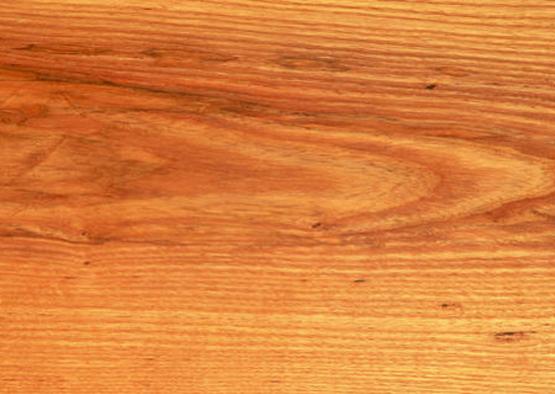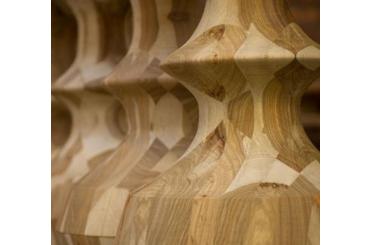American ash is the trade name for a number of sub species of ash that grow throughout the eastern USA. It is a versatile and attractive hardwood with good strength properties.
Northern Ash, Southern Ash, White Ash, American White Ash, Brown Ash
Fraxinus spp.

American ash is the trade name for a variety of sub species of ash that are grown in the eastern parts of the USA. It is similar in appearance to European ash, with very pale sapwood and heartwood that varies from a greyish brown to light brown, or a pale yellow with brown streaks. The timber or veneer from the American ash is sometimes sold based on colour, with White Ash referring to the sapwood and brown ash referring to the heartwood. It is available in a wide range of grades and specifications.
American ash has good strength properties and is usually straight-grained with a uniform texture. The timber has good hardness and steam bends well; it also machines well and is an excellent timber for woodturning. Overall, American ash is easily worked, responding well to nailing, screwing and gluing. It can also be polished to a very high finish. The heartwood is not resistant to decay and is moderately resistant to preservative treatment, limiting the timber to interior applications. The sapwood, however, is permeable.
Common applications for American ash include furniture, flooring, doors, architectural interiors, high-end joinery and mouldings, cabinetry, paneling in the form of veneers, tool handles, sports goods and turnings. It is also becoming popular in the construction of electric guitars. It is an attractive and versatile timber for a vast range of interior applications.
American ash is readily available in the eastern USA, where the various sub species grow. It is available in Australia from specialist timber suppliers as both sawn timber and veneer.
Shrinkage
| Very Low | Low | Medium | High | Very High | |
|---|---|---|---|---|---|

|
|||||
Tangential : |
3.20%
|
||||
Radial : |
2.00%
|
||||
Unit Movement Tangential: |
0.27%
|
||||
Unit Movement Radial: |
0.17%
|
Strength Group

Very High |
High |
Reasonably High |
Medium High |
Medium |
Reasonably Low |
Low |
Very Low |
||
Unseasoned: |
S1 |
S2 |
S3 |
S4 |
S5 |
S6 |
S7 |
S8 |
|
|---|---|---|---|---|---|---|---|---|---|
 |
|||||||||
Seasoned: |
SD1 |
SD2 |
SD3 |
SD4 |
SD5 |
SD6 |
SD7 |
SD8 |
|
 |
Stress Grade

| Structural No. 1 |
Structural No. 2 |
Structural No. 3 |
Structural No. 4 |
Structural No. 5 |
|
Unseasoned: |
F8 |
F7 |
F5 |
F4 |
|
Seasoned: |
F14 |
F11 |
F8 |
F7 |
F5 |
Density per Standard

Seasoned: |
690kg/m3
|
|---|---|
Unseasoned: |
800kg/m3
|
Joint Group

Very High |
High |
Reasonably High |
Medium |
Low |
Very Low |
|
Unseasoned: |
J1 |
J2 |
J3 |
J4 |
J5 |
J6 |
|---|---|---|---|---|---|---|
Seasoned: |
JD1 |
JD2 |
JD3 |
JD4 |
JD5 |
JD6 |
 |
Colour

| White, yellow, pale straw to light brown | Pink to pink brown | Light to dark red | Brown, chocolate, mottled or streaky | |
 |
||||
Mechanical Properties
Modulus of Rupture - Unseasoned: |
66
|
|---|---|
Modulus of Rupture - Seasoned: |
103
|
Modulus of Elasticity - Unseasoned: |
9.9
|
Modulus of Elasticity - Seasoned: |
12
|
Maximum Crushing Strength - Unseasoned:  |
27.5
|
Maximum Crushing Strength - Seasoned: |
51
|
Impact - Unseasoned: |
|
Impact - Seasoned: |
|
Toughness - Unseasoned: |
|
Toughness - Seasoned: |
|
Hardness - Unseasoned: |
4.3
|
Hardness - Seasoned: |
5.9
|
Durability
| Low | Moderate | Reasonably High | High | |
| (0 - 5 yrs) | (5 - 15 yrs) | (15 - 25 yrs) | (more than 25 yrs) | |
In-Ground: |
 |
|||
| (0 - 7 yrs) | (7 - 15 yrs) | (15 - 40 yrs) | (More than 40 yrs) | |
Above ground: |
 |
|||
| (0 - 20 yrs, usually < 5) | (21 - 40 yrs) | (41 - 64 yrs) | (More than 60 yrs) | |
Marine Borer Resistance: |
Lyctid Borer Susceptibility: |
Susceptible |
|---|---|
Lyctid Borer Susceptibility - Other: |
|
Termite Resistance: |
Not Resistant
|
Fire Properties
American ash varies in appearance according to the sub species from which the timber or veneer is sourced. Sapwood is generally pale to almost white; heartwood ranges from greyish brown to light brown, to pale yellow with brown streaks. It is sometimes sold separately according to sapwood colour as white ash, or heartwood colour as brown ash. It is a straight-grained wood with a coarse but uniform texture. Common to the species are light brown flecks or mineral streaks but these are not considered to be defects and are treated as a natural characteristic of the timber.
American ash is a popular and versatile timber used in a vast range of interior applications, such as flooring, furniture, joinery and cabinetry, mouldings, panelling, sports equipment and turning. Available as a proprietary thermally modified timber, suitable for external cladding and decking. It is also becoming popular in the construction of solid-bodied electric guitars.
American ash is highly workable, responding well to steam bending, nailing, gluing, sawing, carving, moulding, etc. It is an excellent woodturning timber and polishes to a high finish.


